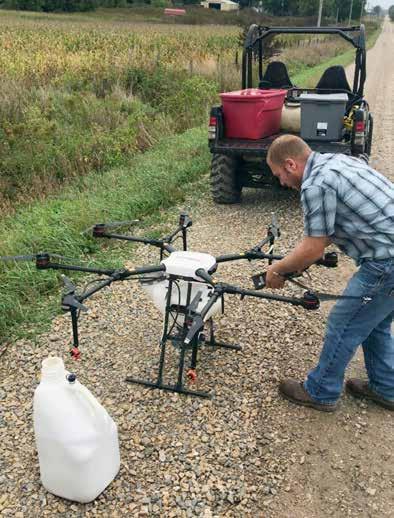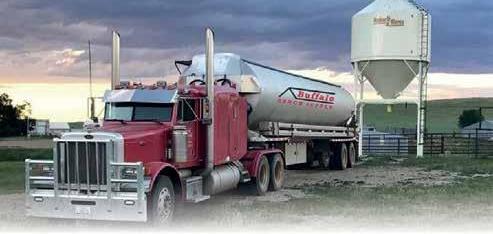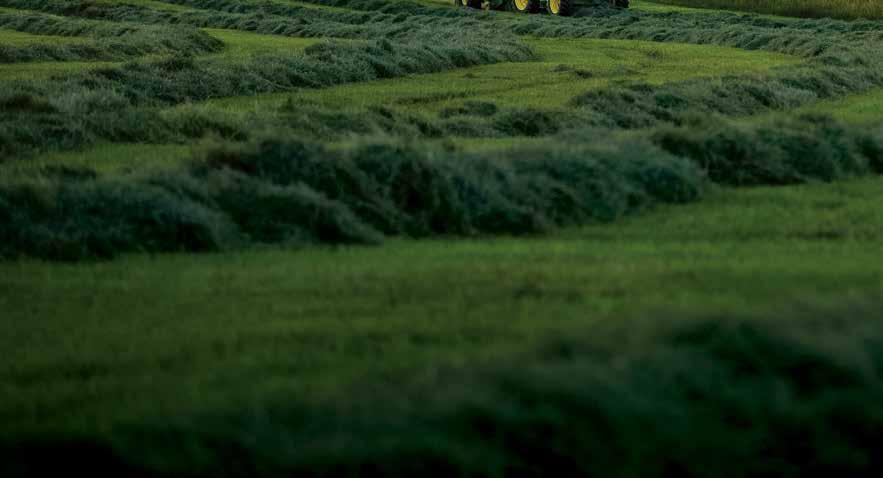
11 minute read
DRONE-GROWN
AGRICULTURAL DRONES MAY BE THE FUTURE OF SPRAYING, BUT FOR RIGHT NOW THEY ARE LIMITED TO SPECIALIZED AREAS AND NEEDS.
PHOTO COURTESY RANTIZO.
Automating the future of ag
BY TAMARA CHOAT

We might not be driving Jetsonenvisioned flying cars yet, but in the past five years unmanned aerial systems, or drones, have merged from futuristic novelties into farm equipment. This crop season will bring swarms of drones that spray and seed cover crops – with a future as limitless as the horizon.
In a report from the Federal Aviation Administration, which oversees drone usage and regulations, the worldwide agricultural drone market in 2017 was valued at $990 and projected to explode to $6.73 billion by 2025. The commercial drone market, including ag usage, is expected to triple in size by 2023 with more than 15,000 commercial drones registered each month.

RANTIZO CONTRACTOR NICK WILLIAMS OF PARKSTON, S.D., AND CEO MICHAEL OTT.
PHOTO COURTESY RANTIZO.
Nick Williams of Parkston, S.D., launched Williams Drones last June and is looking forward to starting his first full summer work season. He purchased a swarm of three drones with spraying and spreading kits through a contract partnership with Rantizo, a turnkey agricultural drone service provider based out of Iowa City, Iowa, that provides everything, from hardware and software to training and licensing support, insurance and even customer leads.
Williams, who owns the business with his wife, Katie, has conducted several drone demos to promote their business, and has received a lot of interest. He plans to offer spraying and seeding, particularly cover crops.
“We’re not aiming to replace ground rigs by any means – drones are just another tool that people have available to get to the places where the sprayers and planes can’t get to,” he says.
Rantizo estimates their drones can cover up to 14 acres per hour at 3 gallons per acre, at about 100 acres per day. With their company exemptions, a pilot can fly three drones at a time and cover up to 300 acres per day. While this clearly doesn’t replace an on-ground or plane system, Williams says drones solve issues of accuracy and access. “If you have a problem with just five acres, we can go spray that part with much more precision than a spray plane. We can also get in the field right after a rain or when the corn is too tall, or work in smaller fields that are surrounded by trees or telephone poles.”
Everything Williams needs for a drone job is in his trailer, and he pulls up to the edge of the field – or as close as he can
Building
RANTIZO IS THE LEADING COMPANY IN USE OF AGRICULTURAL DRONES.

PHOTO COURTESY RANTIZO.
get – and goes to work. His primary work is application, not mapping, and he prefers to work off of a “shape file,” or digital map, of the field sent to him beforehand. With his Rantizo contract he is allowed to fly three drones at one time, all operated off one controller. The drones hover six feet off the ground and adjust to hills or low areas, and also have collision avoidance radar. They don’t run side-by-side, but instead spread out in formation and rotation, each taking a third of the prescribed area, operating in RTK (Real Time Kinematic is a GPS correction technology technique that provides real-time corrections to location data) with sub-inch accuracy. Each spray tank holds 2.5 gallons, and the batteries last between 5 and 15 minutes. When a drone empties a tank or gets low on charge it returns to the trailer and Williams services it, then it returns to the spot where it stopped spraying. He says with three drones it’s a pretty consistent job to refill tanks and change batteries, but the as technology continues to evolve he sees those processes becoming more streamlined.
Williams says he is looking forward to the continuing advancements Rantizo provides its contractors, including a potential nighttime exemption, as well as technology to run more drones at one time.
Rantizo CEO and founder Michael Ott started the company in 2018 and today they have 30 contractors in 18 states. The company recently received $7.5 million in venture capital from Bayer and is currently hiring to double their staff. They are continually accepting applications for new contractors nationwide.
As part of its service, Rantizo has broken down the complicated process of starting an ag drone business into four steps – all of which they streamline. The first is equipment: they sell and service, as well as provide proprietary software, hardware, and research and development, on their products,
CONTRACTOR RYAN GIBBS LOADING A DRONE FOR COVER CROP SEED APPLICATIONS IN NORTHEAST IOWA.
PHOTO COURTESY RANTIZO.

along with comprehensive training programs. They currently operate using DJI Agras MG-1P drones. Second, they help navigate the FAA certification process, including a Part 107 (a remote pilot certificate), Part 137 (an agricultural operator certificate), and Section 44807 (exemptions to normal drone operations). Third, they assist contractors in the process of working with state pesticide offices to get applicator permits. Fourth, Rantizo offers insurance both for accidental crop damage and equipment coverage.
Ott says their advantage is their software platform and legal exemptions to operate three spray drones at once; to his knowledge they are the only company legally doing this. He acknowledges that the current limitations of drones can’t perform whole field applications efficiently – yet. “We tend to do best in the hardest situations – we market ourselves to treat the problem areas.”
Farm economics in a large part have provided opportunity for this niche.
“A few years ago farmers focused on yield, yield and yield,” says Ott. “Today, people are starting to look at cutting back on input costs and increasing margins per acre.” Fewer inputs will also translate to environmental efficiency.
“For a long time farmers have operated that a little herbicide is good, and a lot is better,” says Ott. “But we know that it is not only more cost effective but also better for everything if you farm 2,000 acres and have 200 that are a pain, to treat the 200 acres.”
As technology advances, the current limitation of 55 pounds is not going to be what changes first, Ott says. Advances will come in the form of more rather than bigger. “It’s always going to be more productive to have three 55-pound drones than one 150-pound drone,” says Ott. “Think of a Roomba cleaning your house – is
RANTIZO SWARMING DRONES HEADED TO WORK.
PHOTO COURTESY RANTIZO.





BLACK THUNDER CREEK RANCH
Newcastle, Weston County, Wyoming 20,333± total contiguous acres: 10,571.42± deeded, 1,960± State lease, 7,802.47± Thunder Basin National Grassland permit. Two sets of improvements. $5,500,000
Contact Cory Clark at (307) 334-2025 or Mark McNamee at (307) 760-9510 FIVE F FEEDERS
Belle Fourche, Butte County, South Dakota 880± deeded acres with 612± irrigated acres & DENR approved 4,000 head feedlot.
$4,000,000
Contact Ron Ensz at (605) 210-0337 or Denver Gilbert at (406) 697-3961 TIGHE RANCH
Morrill, Sioux County, Nebraska 3,694± total deeded acres: 159± acres irrigated by two pivots, 3,535± acres of native grass and dryland hay. $3,400,000
Contact Cory Clark at (307) 334-2025 or Logan Schliinz at (307) 575-5236
PRECISION AG TECH STUDENTS AT MITCHELL TECH IN MITCHELL, S.D. PRACTICE ON ONE OF THE COLLEGE’S DRONES.

PHOTO COURTESY MITCHELL TECH.

RANTIZO DRONES BEING USED TO SANITIZE BASEBALL STADIUMS DURING THE COVID PANDEMIC.
PHOTO COURTESY RANTIZO. it better to double the size of the Roomba or have three Roombas running around?”
He says current bottlenecks involve reloading capacity and as they solve that problem the size of the swarms will increase, which will enable larger capacity. Additional challenges include rural broadband access as well as regulatory aspects – all which Rantizo staff work on daily.
As precision ag companies like Rantizo embrace the future, colleges like Mitchell Tech in Mitchell, S.D., are preparing the job candidates to work in this field. Devon Russell is director of the precision ag program at Mitchell Tech, which combines aspects of electronics, business, agriculture, and technology to meet industry needs. The program averages about 20 students and has a 100 percent job placement rate.
Russell has implemented drones in the curric- “Especially as the regulations are slowly lessened, ulum since 2016, and with grants the program has I see the use of drones increasing,” says Russell. purchased several Trimble UX5 drones and a DJI. “When drones first became available the FAA came One of the classes he instructs specifically prepares down with such harsh regulations it was impossible students to take the Part 107 exam from the FAA to to use them. As we go forward, they are getting more get their remote pilot license. His students combine user-friendly and more automated. their learning in GPS/GIS and field, soil and yield mapping to perform both drone imagery and spray- “This is really just the tip of the iceberg, the possiing operations. Russell says technology advances in bilities are endless.” agriculture are growing so quickly they can be hard to keep up with, but the college has great industry partners who keep them updated and included in their field trainings and product launches. He says the future of automated technology is exploding. Dealer
Although the majority of drone uses in agriculture are in farming, Russell’s students have some fun practicing a ranch application as well – counting cows.
“The local sale barn is near us, and we have a drone that has a thermal camera on it and an automatic counting function, so we fly over there sometimes and practice,” he says. The technology was developed with human search and rescue in mind, but Russell says by changing a few of the parameters they can tally bovines just as easily.
As with all emerging technology, the issues of appropriate use and privacy come to mind, especially in agriculture. Russell says ethics and legal uses are issues he teaches in his courses and are part of the licensing procedure.
With drones a relatively emerging technology, the potential is intriguing. Bulk Cake & Creep Feed Delivery Alfalfa Pellets & Cubes in Bulk Beef, Sheep & Bison Mineral Pack Available



VACCINE PROGRAM
Let’s talk about adding value to your livestock operation with a vaccine program. Call TJ for a quote today!
FREE SHIPPING ON
ANIMAL HEALTH & VACCINE ORDERS OF $50 OR MORE!

207 1st Street West, Buffalo, SD 57720 605-375-3767 www.buffaloranchsupply.com
Introducing the onlybaleryou’lleverneed.


ExploretheinnovativefeaturesofourZeroSeriesRoundBalers.
There’salottoloveaboutthenewZeroSeriesRoundBalers,startingwiththeMegaWide™HC2highcapacityfeedsystem(availableonMandRmodels).Thisnewfeedsystemprecutsthecropasitenters thebalerwhiledeliveringuptoan80%increaseintonnageperhour(comparedtocompetitivemodels). Precutbalescutmixingtimesbyasmuchas58%,potentiallyeliminatingtheneedfortubgrinders,all whileprovidingnutrient-richfeedthatwon’tgotowaste.
You’llalsoappreciatenewimprovementsthataidserviceabilityandboostuptime.Centralizedgrease banksonselectmodelsallowyoutodoallthedailygreasingfromtheground,whileacut-outclutch designprovidesthebestdrivelineprotectionintheindustry.Finally,anewhydraulicdropflooraidswith toughdrivingconditions—helpingyouclearplugsquicklyandeasily.
Italladdsuptoourbestbaleryet.Tolearnmorevisit21stcenturyequipment.com/hay

Developing Solu�ons, Delivering Success
Counton21stCenturyEquipment forallyourhayingneeds.

FromJohnDeerelargesquarebalersandroundbalerstowindrowers,attachmentsandconsumables,your local21stCenturyEquipmentlocationhaseverythingyouneedtokeephayproductionefficientandprofitable.
No No Payments Interest for 120 days*
Onhayproductsandsupplies.
Offer valid on qualifying purchases made between 11/01/2020 to 5/31/2021 and is subject to approved credit on a Multi-UseAccount, a service of John Deere Financial, f.s.b. For agricultural use only.After the promotional period, interest charges will begin to accrue at the regular Multi-UseAccount rate. $200 minimum purchase required. Available at participating dealers, see your local dealer for complete details.
*Must request program

0%for 60Months
Onnewroundbalers.
Offer ends May 3, 2021.
Ourlocations
COLORADO
Burlington 17777 Hwy 385 (719) 346-8213 • (866) 871-6463 Cheyenne Wells 44578 Hwy 40 (719) 767-5605 • (800) 275-4396 Flagler 4707 County Road V (719) 765-4428 • (800) 764-4428 Fort Morgan 20911 Hwy 34 (970) 867-9434 • (888) 529-5261 Holyoke 39924 Hwy 6 (970) 854-3112 • (800) 584-9199 Sterling 18793 Hwy 6 (970) 522-6697 • (800) 874-6291 Wray 36535 Hwy 385 (970) 332-4141 • (877) 260-0241 Yuma 704 East 8thAve. (970) 848-5482 • (800) 848-5482 NEBRASKA

Alliance 1520 West 10th St. (308) 762-5870 • (888) 762-5870 Bridgeport 9738 US 26 (308) 262-1110 • (800) 682-5121
Gordon 6742 State Hwy 27 (308) 282-0665 • (800) 535-4450 Imperial 1001 North Hwy 61 (308) 882-4326 • (800) 525-4934 Ogallala 101 Road East 80 (308) 284-4049 • (800) 658-4227 Scottsbluff 3609 Hwy 26 (308) 632-4440 • (800) 658-4440 Sidney 1901 Link 17J (308) 254-2511 • (866) 233-2511 WYOMING
Torrington 5180 US Hwy 26 (307) 532-7071 • (800) 658-3254

